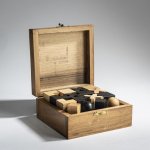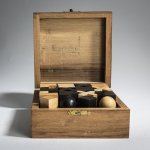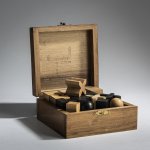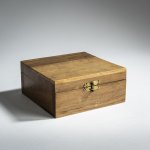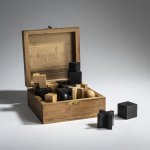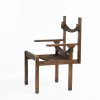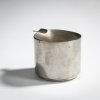Lot: 66
Josef Hartwig
Bauhaus chess set 'XVI', 1924
32 pieces. H. 2-5 cm. Made at Bauhaus Dessau, c. 1930. Maple, partially stained dark.
In original walnut box. H. 6.1 x 13.4 x 13.7 cm. Marked: HARTWIG BAUHAUS DESSAU GES.GESCH. Provenance: Design dealer Germany, former family West Germany; the father of the original owner had acquired the chess set at Bauhaus Dessau during his training as handicraft teacher in Leipzig.
Hammer Price: 9,000 €
07. December 2021 at 3:00 PM CET
Literature:
The chess set by Josef Hartwig is one of the most successful products designed at the Weimar Bauhaus. In 1922, the graduate of the Munich Academy, who worked from 1921 to 1925 as a foreman in the workshop for wood and sculpture at the Weimar Bauhaus, began to design a chess set that differs fundamentally from traditional forms. Hartwig designed the tokens from simple stereometric shapes, from cubes, cylinders and spheres. Initially, the figures were handcrafted, but the goal was industrial production. Hartwig himself explained the genesis of the forms in 1924: “Pawn and rook move at right angles to the edge of the board: expressed by the cube. The knight moves at right angles in a hook shape on four fields: four cubes combined at right angles. The bishop moves diagonally to the edge of the board: a cross cut from the cube. The king moves at right angles and diagonally: a small cube across a corner on a larger one. The queen, the most agile figure, consists of a cylinder and a ball. ”(The Bauhaus chess game by Josef Hartwig, p. 7) Bauhaus-Archiv Berlin Das Bauhaus-Schachspiel von Josef Hartwig, Berlin 2006, p. 19; Hahn, Experiment Bauhaus, Dessau 1988, p. 401; Bauhaus-Archiv, coll. cat., Berlin 1987, pp. 149-50, no. 288; Exh. cat. Bauhaus 7, Galerie am Sachsenplatz, Leipzig 1991, fig. p. 43, no. 134.
Read our Terms & Conditions.





